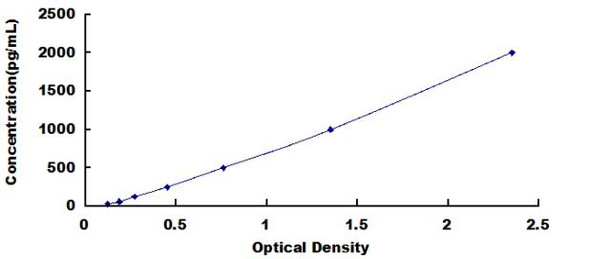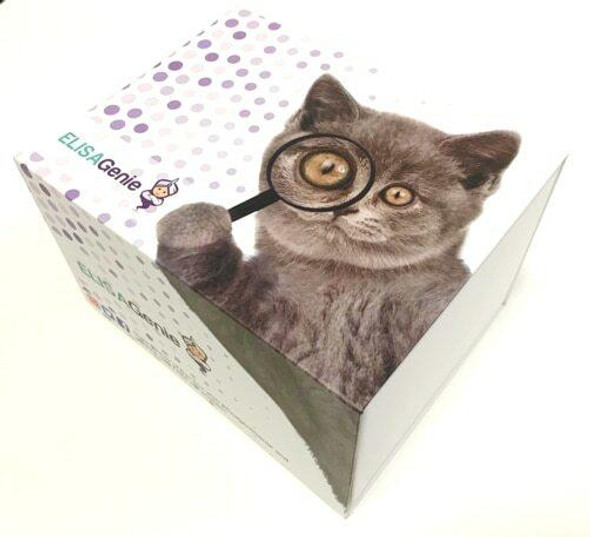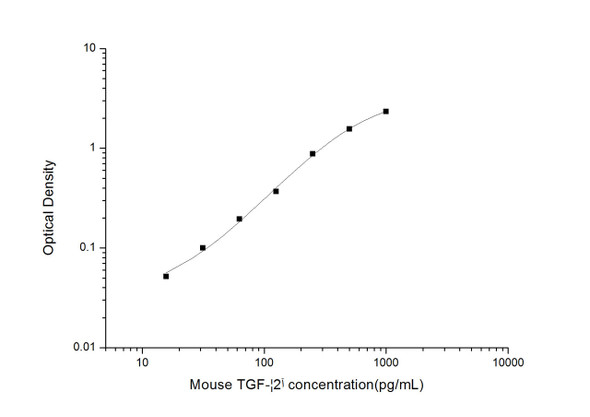Rat Transforming growth factor beta-2 (Tgfb2) ELISA Kit (RTEB0157)
- SKU:
- RTEB0157
- Product Type:
- ELISA Kit
- Size:
- 96 Assays
- Uniprot:
- Q07257
- Range:
- 15.6-1000 pg/mL
- ELISA Type:
- Sandwich
- Synonyms:
- TGF-Beta2, Transforming Growth Factor Beta2, TGF-Beta2, TGFBeta2, TGFB2, BSC-1 cell growth inhibitor, Cetermin, G-TSF, Polyergin, polyergin, TGF-beta2, TGF-beta-2, transforming growth factor beta-2
- Reactivity:
- Rat
Description
Rat Transforming growth factor beta-2 (Tgfb2) ELISA Kit
The Rat Transforming Growth Factor Beta 2 (TGFB2) ELISA Kit is a valuable tool for accurately measuring TGFB2 levels in rat samples. This kit offers high sensitivity and specificity, providing dependable and consistent results for a variety of research applications.TGFB2 is an important protein involved in cell growth, differentiation, and immune response regulation. Dysregulation of TGFB2 has been linked to various diseases, including cancer, fibrosis, and autoimmune disorders.
By accurately measuring TGFB2 levels, researchers can gain valuable insights into disease mechanisms and potential therapeutic targets.With its easy-to-use format and reliable performance, the Rat TGFB2 ELISA Kit is a key asset for researchers studying the role of TGFB2 in health and disease. Trust in this kit for precise and reproducible results in your research projects.
| Product Name: | Rat Transforming growth factor beta-2 (Tgfb2) ELISA Kit |
| SKU: | RTEB0157 |
| Size: | 96T |
| Target: | Rat Transforming growth factor beta-2 (Tgfb2) |
| Synonyms: | Transforming growth factor beta-2, TGF-beta-2, Tgfb2 |
| Assay Type: | Sandwich |
| Detection Method: | ELISA |
| Reactivity: | Rat |
| Detection Range: | 15.6-1000pg/mL |
| Sensitivity: | 7.83pg/mL |
| Intra CV: | 5.2% | ||||||||||||||||||||
| Inter CV: | 7.5% | ||||||||||||||||||||
| Linearity: |
| ||||||||||||||||||||
| Recovery: |
| ||||||||||||||||||||
| Function: | Transforming growth factor beta-2: Multifunctional protein that regulates various processes such as angiogenesis and heart development (By similarity). Activation into mature form follows different steps: following cleavage of the proprotein in the Golgi apparatus, Latency-associated peptide (LAP) and Transforming growth factor beta-2 (TGF-beta-2) chains remain non-covalently linked rendering TGF-beta-2 inactive during storage in extracellular matrix (By similarity). At the same time, LAP chain interacts with 'milieu molecules', such as LTBP1 and LRRC32/GARP, that control activation of TGF-beta-2 and maintain it in a latent state during storage in extracellular milieus (By similarity). Once activated following release of LAP, TGF-beta-2 acts by binding to TGF-beta receptors (TGFBR1 and TGFBR2), which transduce signal (By similarity). |
| Uniprot: | Q07257 |
| Sample Type: | Serum, plasma, tissue homogenates, cell culture supernates and other biological fluids |
| Specificity: | Natural and recombinant rat Transforming growth factor beta-2 proprotein |
| Sub Unit: | Interacts with the serine proteases, HTRA1 and HTRA3 (By similarity). Interacts with ASPN (By similarity). Interacts with MFAP5 (By similarity). Latency-associated peptide: Interacts with Transforming growth factor beta-2 (TGF-beta-2) chain; interaction is non-covalent and maintains (TGF-beta-2) in a latent state (By similarity). Latency-associated peptide: Interacts with LRRC32/GARP; leading to regulate activation of TGF-beta-2 (By similarity). Latency-associated peptide: Interacts with NREP; the interaction results in a decrease in TGFB2 autoinduction (By similarity). Transforming growth factor beta-2: Homodimer; disulfide-linked (By similarity). Transforming growth factor beta-2: Interacts with TGF-beta receptors (TGFBR1 and TGFBR2), leading to signal transduction (By similarity). |
| Research Area: | Cancer |
| Subcellular Location: | Transforming growth factor beta-2 Secreted |
| Storage: | Please see kit components below for exact storage details |
| Note: | For research use only |
| UniProt Protein Function: | TGFB2: TGF-beta 2 has suppressive effects on interleukin-2 dependent T-cell growth. Homodimer; disulfide-linked. Heterodimers with TGFB1 and with TGFB3 have been found in bone. Interacts with the serine proteases, HTRA1 and HTRA3. Interacts with ASPN. Belongs to the TGF-beta family. 2 isoforms of the human protein are produced by alternative splicing. |
| UniProt Protein Details: | Protein type:Cell development/differentiation; Motility/polarity/chemotaxis; Secreted; Secreted, signal peptide Cellular Component: axon; basement membrane; cell soma; cell surface; cytoplasm; endosome; extracellular matrix; extracellular region; extracellular space; secretory granule; trans-Golgi network Molecular Function:beta-amyloid binding; cytokine activity; protein heterodimerization activity; protein homodimerization activity; protein N-terminus binding; punt binding; receptor binding; receptor signaling protein serine/threonine kinase activity; transforming growth factor beta receptor binding Biological Process: activation of protein kinase activity; aging; axon guidance; blood vessel development; blood vessel remodeling; cardiac muscle cell proliferation; cardioblast differentiation; cartilage condensation; cell cycle arrest; cell death; cell development; cell migration; cell morphogenesis; collagen fibril organization; dopamine biosynthetic process; embryonic gut development; embryonic limb morphogenesis; embryonic neurocranium morphogenesis; epithelial to mesenchymal transition; extracellular matrix organization and biogenesis; eye development; female pregnancy; glial cell migration; gut development; hair follicle development; hair follicle morphogenesis; heart development; heart morphogenesis; hemopoiesis; hindbrain development; inner ear development; intercellular junction assembly and maintenance; kidney development; lung development; male gonad development; negative regulation of apoptosis; negative regulation of cell growth; negative regulation of cell proliferation; negative regulation of epithelial cell proliferation; negative regulation of immune response; negative regulation of Ras protein signal transduction; negative regulation of release of sequestered calcium ion into cytosol; neural tube closure; neuron development; neuron fate commitment; neutrophil chemotaxis; palate development; pancreas development; positive regulation of apoptosis; positive regulation of cardioblast differentiation; positive regulation of catagen; positive regulation of cell adhesion mediated by integrin; positive regulation of cell cycle; positive regulation of cell growth; positive regulation of cell migration; positive regulation of cell proliferation; positive regulation of heart contraction; positive regulation of immune response; positive regulation of integrin biosynthetic process; positive regulation of neuron apoptosis; positive regulation of ossification; positive regulation of phosphoinositide 3-kinase cascade; positive regulation of protein secretion; positive regulation of stress-activated MAPK cascade; protein amino acid phosphorylation; regulation of actin cytoskeleton organization and biogenesis; regulation of apoptosis; regulation of cell growth; regulation of cell proliferation; regulation of MAPKKK cascade; regulation of transforming growth factor-beta2 production; response to cold; response to cytokine stimulus; response to drug; response to estradiol stimulus; response to estrogen stimulus; response to hypoxia; response to organic nitrogen; response to progesterone stimulus; response to radiation; response to retinoic acid; response to vitamin D; response to wounding; salivary gland morphogenesis; skeletal development; skeletal muscle development; SMAD protein nuclear translocation; somatic stem cell division; thyroid gland development; transforming growth factor beta receptor signaling pathway; uterus development; wound healing |
| NCBI Summary: | binds the transforming growth factor-beta receptor; plays a role in regulation of cell growth and proliferation; may be involved in mesenchymal-epithelial cell interactions during development [RGD, Feb 2006] |
| UniProt Code: | Q07257 |
| NCBI GenInfo Identifier: | 20981713 |
| NCBI Gene ID: | 81809 |
| NCBI Accession: | Q07257.2 |
| UniProt Secondary Accession: | Q07257,Q63574, Q9QW26, Q9R281, Q9R298, Q9R2B8, Q9WUQ8 |
| UniProt Related Accession: | Q07257 |
| Molecular Weight: | 47,728 Da |
| NCBI Full Name: | Transforming growth factor beta-2 |
| NCBI Synonym Full Names: | transforming growth factor, beta 2 |
| NCBI Official Symbol: | Tgfb2 |
| NCBI Official Synonym Symbols: | TGF-B2 |
| NCBI Protein Information: | transforming growth factor beta-2; TGF-beta-2; TGF beta 2 protein |
| UniProt Protein Name: | Transforming growth factor beta-2 |
| Protein Family: | Transforming growth factor |
| UniProt Gene Name: | Tgfb2 |
| UniProt Entry Name: | TGFB2_RAT |
| Component | Quantity (96 Assays) | Storage |
| ELISA Microplate (Dismountable) | 8×12 strips | -20°C |
| Lyophilized Standard | 2 | -20°C |
| Sample Diluent | 20ml | -20°C |
| Assay Diluent A | 10mL | -20°C |
| Assay Diluent B | 10mL | -20°C |
| Detection Reagent A | 120µL | -20°C |
| Detection Reagent B | 120µL | -20°C |
| Wash Buffer | 30mL | 4°C |
| Substrate | 10mL | 4°C |
| Stop Solution | 10mL | 4°C |
| Plate Sealer | 5 | - |
Other materials and equipment required:
- Microplate reader with 450 nm wavelength filter
- Multichannel Pipette, Pipette, microcentrifuge tubes and disposable pipette tips
- Incubator
- Deionized or distilled water
- Absorbent paper
- Buffer resevoir
*Note: The below protocol is a sample protocol. Protocols are specific to each batch/lot. For the correct instructions please follow the protocol included in your kit.
Allow all reagents to reach room temperature (Please do not dissolve the reagents at 37°C directly). All the reagents should be mixed thoroughly by gently swirling before pipetting. Avoid foaming. Keep appropriate numbers of strips for 1 experiment and remove extra strips from microtiter plate. Removed strips should be resealed and stored at -20°C until the kits expiry date. Prepare all reagents, working standards and samples as directed in the previous sections. Please predict the concentration before assaying. If values for these are not within the range of the standard curve, users must determine the optimal sample dilutions for their experiments. We recommend running all samples in duplicate.
| Step | |
| 1. | Add Sample: Add 100µL of Standard, Blank, or Sample per well. The blank well is added with Sample diluent. Solutions are added to the bottom of micro ELISA plate well, avoid inside wall touching and foaming as possible. Mix it gently. Cover the plate with sealer we provided. Incubate for 120 minutes at 37°C. |
| 2. | Remove the liquid from each well, don't wash. Add 100µL of Detection Reagent A working solution to each well. Cover with the Plate sealer. Gently tap the plate to ensure thorough mixing. Incubate for 1 hour at 37°C. Note: if Detection Reagent A appears cloudy warm to room temperature until solution is uniform. |
| 3. | Aspirate each well and wash, repeating the process three times. Wash by filling each well with Wash Buffer (approximately 400µL) (a squirt bottle, multi-channel pipette,manifold dispenser or automated washer are needed). Complete removal of liquid at each step is essential. After the last wash, completely remove remaining Wash Buffer by aspirating or decanting. Invert the plate and pat it against thick clean absorbent paper. |
| 4. | Add 100µL of Detection Reagent B working solution to each well. Cover with the Plate sealer. Incubate for 60 minutes at 37°C. |
| 5. | Repeat the wash process for five times as conducted in step 3. |
| 6. | Add 90µL of Substrate Solution to each well. Cover with a new Plate sealer and incubate for 10-20 minutes at 37°C. Protect the plate from light. The reaction time can be shortened or extended according to the actual color change, but this should not exceed more than 30 minutes. When apparent gradient appears in standard wells, user should terminatethe reaction. |
| 7. | Add 50µL of Stop Solution to each well. If color change does not appear uniform, gently tap the plate to ensure thorough mixing. |
| 8. | Determine the optical density (OD value) of each well at once, using a micro-plate reader set to 450 nm. User should open the micro-plate reader in advance, preheat the instrument, and set the testing parameters. |
| 9. | After experiment, store all reagents according to the specified storage temperature respectively until their expiry. |
When carrying out an ELISA assay it is important to prepare your samples in order to achieve the best possible results. Below we have a list of procedures for the preparation of samples for different sample types.
| Sample Type | Protocol |
| Serum | If using serum separator tubes, allow samples to clot for 30 minutes at room temperature. Centrifuge for 10 minutes at 1,000x g. Collect the serum fraction and assay promptly or aliquot and store the samples at -80°C. Avoid multiple freeze-thaw cycles. If serum separator tubes are not being used, allow samples to clot overnight at 2-8°C. Centrifuge for 10 minutes at 1,000x g. Remove serum and assay promptly or aliquot and store the samples at -80°C. Avoid multiple freeze-thaw cycles. |
| Plasma | Collect plasma using EDTA or heparin as an anticoagulant. Centrifuge samples at 4°C for 15 mins at 1000 × g within 30 mins of collection. Collect the plasma fraction and assay promptly or aliquot and store the samples at -80°C. Avoid multiple freeze-thaw cycles. Note: Over haemolysed samples are not suitable for use with this kit. |
| Urine & Cerebrospinal Fluid | Collect the urine (mid-stream) in a sterile container, centrifuge for 20 mins at 2000-3000 rpm. Remove supernatant and assay immediately. If any precipitation is detected, repeat the centrifugation step. A similar protocol can be used for cerebrospinal fluid. |
| Cell culture supernatant | Collect the cell culture media by pipette, followed by centrifugation at 4°C for 20 mins at 1500 rpm. Collect the clear supernatant and assay immediately. |
| Cell lysates | Solubilize cells in lysis buffer and allow to sit on ice for 30 minutes. Centrifuge tubes at 14,000 x g for 5 minutes to remove insoluble material. Aliquot the supernatant into a new tube and discard the remaining whole cell extract. Quantify total protein concentration using a total protein assay. Assay immediately or aliquot and store at ≤ -20 °C. |
| Tissue homogenates | The preparation of tissue homogenates will vary depending upon tissue type. Rinse tissue with 1X PBS to remove excess blood & homogenize in 20ml of 1X PBS (including protease inhibitors) and store overnight at ≤ -20°C. Two freeze-thaw cycles are required to break the cell membranes. To further disrupt the cell membranes you can sonicate the samples. Centrifuge homogenates for 5 mins at 5000xg. Remove the supernatant and assay immediately or aliquot and store at -20°C or -80°C. |
| Tissue lysates | Rinse tissue with PBS, cut into 1-2 mm pieces, and homogenize with a tissue homogenizer in PBS. Add an equal volume of RIPA buffer containing protease inhibitors and lyse tissues at room temperature for 30 minutes with gentle agitation. Centrifuge to remove debris. Quantify total protein concentration using a total protein assay. Assay immediately or aliquot and store at ≤ -20 °C. |
| Breast Milk | Collect milk samples and centrifuge at 10,000 x g for 60 min at 4°C. Aliquot the supernatant and assay. For long term use, store samples at -80°C. Minimize freeze/thaw cycles. |










